

 |
July 3, 1994: Bryce Canyon NP/Cedar Breaks NM |
 |
Return to the Index for Our Western Trip |
This morning, July 4th, we got up fairly early and went off to get some pictures before we left for Phoenix. We wanted to see some of the big new hotels, and fortunately we were staying in just the right place for that. What we ended up doing was going outside the MGM Grand and beginning our walk on the pedestrian overpass that leads from the MGM Grand to the vacant parcel on the northwest corner of Las Vegas Boulevard (N-S) (locally referred to as "The Strip") and Tropicana Avenue (E-W).
|
We began on the elevated pedestrian walkway between the MGM Grand and the future mega-hotel/casino New York, New York, which has just been announced but which won't open for another three years.
We walked down and across the front of the MGM Grand and across the elevated walkway leading to the Tropicana; this gave us good views of the Excalibur across the street. We walked down the east side of The Strip and then crossed over to the Luxor. This was the newest hotel of the four major ones here, so we went inside to have a look around. When we came out, we walked north along the west side of The Strip to end up at the southwest corner where there were good views of the MGM Grand itself.
So you can use that scrollable aerial view if you wish to follow us around this morning.
|
I might point out that in the years between this visit and our next one, New York, New York was constructed to complete the corner, and some other new mega-hotels were built both north and south along The Strip. Although Las Vegas doesn't have the most hotels among American cities when ranked by the number of hotels, the hotels here are so gigantic that it has, by far, the most hotel rooms. The city's current inventory shows Las Vegas with 152,275 rooms in 355 hotels. Phoenix has the most hotels with 597 while Orlando has the second-highest number of hotel rooms with 144,125.
The land on which the Excalibur now sits was originally the proposed site of the Xanadu Resort envisioned in the 1970s. The 1730-room Asian-tropical themed resort would have been the first mega resort in Las Vegas. The project was never built because its developers could not reach an agreement with the city on infrastructure improvements such a large project would have required.
Circus Circus Enterprises constructed The Excalibur which opened in 1990 as the largest hotel in the world with just under 4,000 rooms and covering over 70 acres. At the time of our visit, it was no longer the largest hotel in the city; both the MGM Grand and the Luxor, which we'll visit shortly, are larger.
Fred thought the view across the street to the Excalibur made a good panorama, and so he used that camera to take the picture below- which also shows the Luxor to the south of the Excalibur:
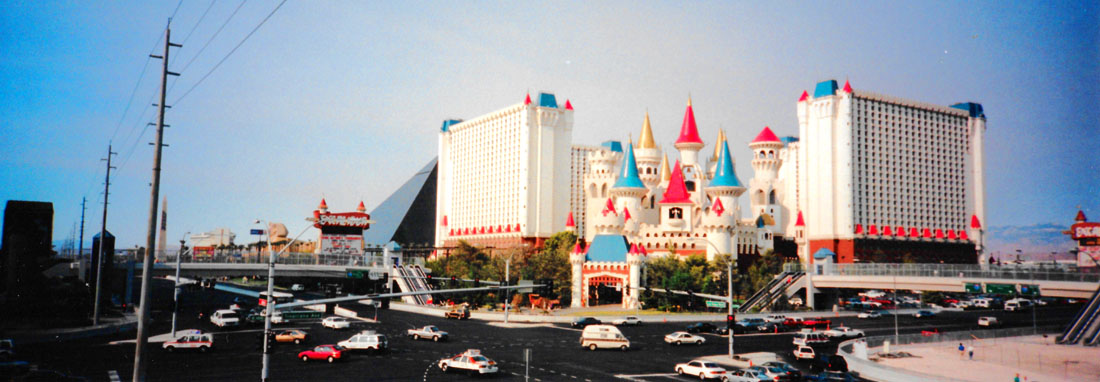 |
Excalibur was designed in line with the "theme resort" strategy popular among some casino operators during the 1990s which included the traditional Las Vegas gaming experience coupled with family-oriented elements. I have been inside The Excalibur before- it has a Medieval motif throughout, with all the restaurants and showrooms named for something from the period. There is the Round Table buffet, the King Arthur lounge, Merlin's showroom, and so on. Actually, I thought all that to be a little cheezy, and I guess other folks did too, for most of the medieval themed statues and scenery were removed as part of a four-year renovation and modernization project in the early 2000s.
|
|
Of course, it's not the hotel that really matters- its the casino, and the MGM Grand has the largest casino in the county- 170,000 square feet. (Again for you trivia buffs, the MGM Grand Las Vegas casino is only the eighth largest in the world. It is surpassed in the United States by Foxwoods in Connecticut (340,000 square feet) and six casinos in Macau, China (the largest of which is over half a million square feet).) The property includes five outdoor pools, rivers, and waterfalls that cover 6.6 acres a 380,000 sq ft convention center, the MGM Grand Garden Arena, and the Grand Spa. It also houses numerous shops, night clubs, and restaurants.
Just before we went up the escalator to the bridge that would take us across Tropicana Blvd. to the Tropicana Hotel, Fred did another panoramic picture. The grounds of the Tropicana are at left and the Excalibur is at right:
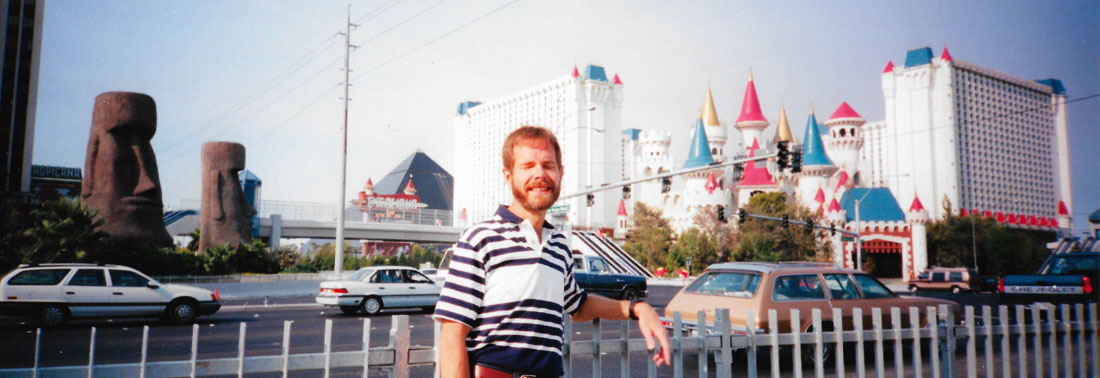 |
It is only about eight-thirty in the morning, but it is already getting quite warm. You will notice a fence behind me; this location, the Tropicana – Las Vegas Boulevard intersection, has the most hotel rooms of any intersection in the world and is extremely busy. Pedestrians are not allowed to cross at street level. Instead, the four huge hotels on these corners are linked by overhead pedestrian bridges.
|
In 1955, Ben Jaffe, an executive of the Fontainebleau Miami Beach, came to Las Vegas and bought the 40-acre parcel on this corner to build what he promised would be the finest hotel in Las Vegas, and which would feature a Cuban ambience. Over schedule and over budget, Jaffe had to sell his interest in the Fontainebleau to complete the project, which finally opened in April 1957.
Jaffe first leased the property to his associate, Phil Kastel, but the Gaming Control Board found links to organized crime. Jaffe eventually sold his interest in the hotel to the owner of The Las Vegas Club (1959). In the 1960s, the Tropicana fared poorly from competition with larger hotels like Caesars Palace and the Las Vegas Hilton. The hotel was sold in 1968 to Trans-Texas Airways and two more times by 1975. A new tower was constructed in 1977, but in 1979 a skimming operation by Kansas City organized crime members was discovered, and the owners were forced to sell. Ramada Inns, Inc. bought the Tropicana in December 1979, constructed a new tower in 1986 and then sold the property in 1989 to the Aztar Corporation, its current owners.
This was one hotel we did not go inside, perhaps because we were just a trifle short of time, wanting to get some more pictures and also get to the Luxor in time to take one of the animated rides in the lobby. Fred likes water features, of course, and although this one is a bit like kitsch, it was interesting nevertheless. It was also time for another panoramic shot looking towards the Excalibur:
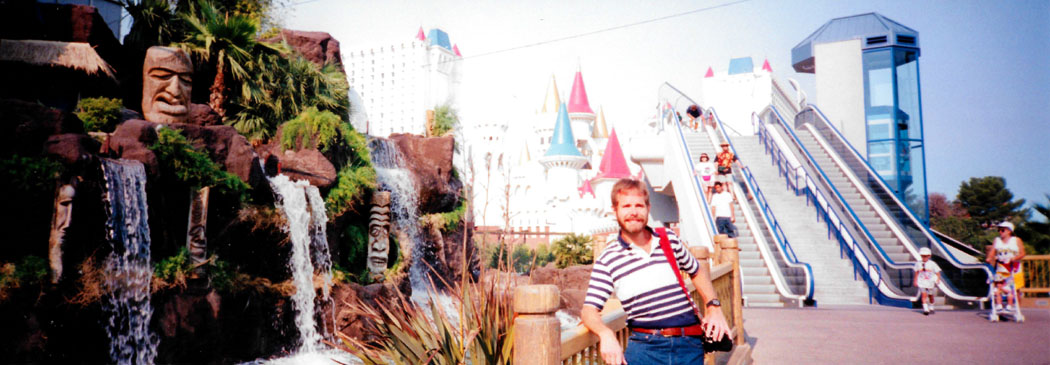 |
We walked around the corner and headed south along The Strip, going one large block to come opposite the Luxor Hotel and Casino. On the way down the street, Fred had me take another panoramic shot with him in it:
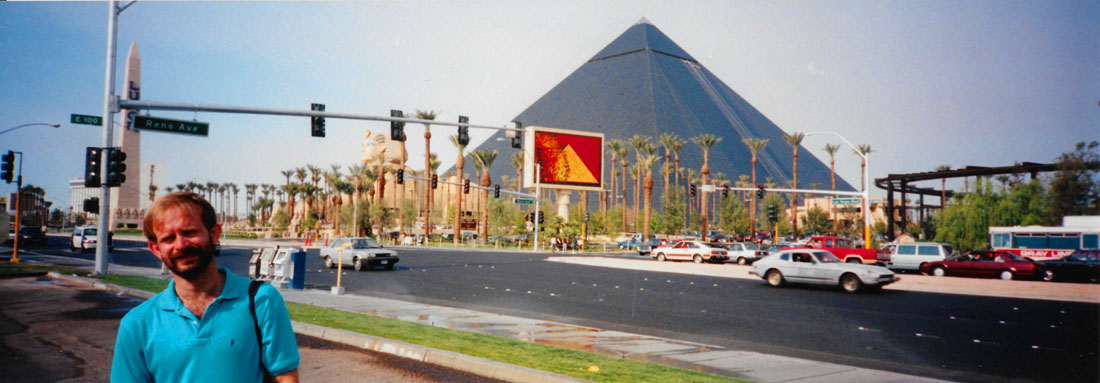 |
We crossed the street that runs behind the Tropicana, and then we were opposite the Luxor on the east side of The Strip. This was a good place to take a picture of this new hotel. (The picture was spoiled by a huge sign right in front of the hotel advertising rental car rates, but today I have the capability to remove it.)
|
This shot was taken from across the street near the parking garage for the Tropicana (3). I had to get as far back to get the whole thing in. Actually, the Luxor is larger than the pyramids (although it doesn't seem so). At the peak is a powerful laser, which shines straight up at night. I read in Popular Science that there are two man-made things that can be seen with the naked eye from orbit. One is the laser atop the Luxor Hotel, and the other is the Great Wall of China. I am told that rooms close to the center of the structure command higher rates than those on the outside, because a lot of people want to maximize the effect of pyramid power, believe it or not.
When the resort opened, it featured the Nile River Tour which was a river ride that carried guests to different parts of the pyramid and passed by pieces of ancient artwork on a river that encircled the casino- that's the ride that we took today. The casino also featured King Tut’s Tomb and Museum, a duplicate of King Tutankhamen’s tomb as found in the Valley of the Kings near Luxor, Egypt. It was good that we saw some of these things and took that ride, because when MGM Resorts bought the Luxor in the 2000s, they spent a great deal of money to remodel it, removing much of the ancient Egyptian theme and replacing it with more adult-oriented and modern lounges, restaurants and clubs.
I took out the large advertising sign that marrred the picture, but if you imagine the cars and all the street lamps and such to be gone, you'd have the impression that you were in the desert looking at one of the pyramids.
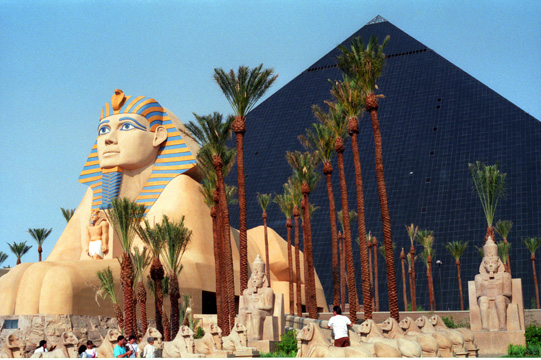 The Luxor Hotel and Casino Underneath the Sphinx is the port d'cochere for the Luxor; you can see the entry for the cars as that black rectangle in the center of the Sphinx's body. All the restaurants and showrooms here are named for something Egyptian, like the Pyramid lounge, the Queen Nefertiti buffet, and so on. |
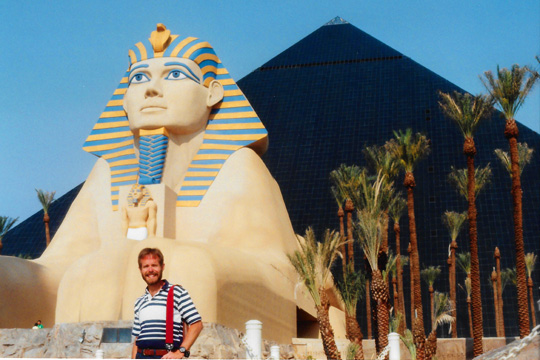 The "Sphinx" at the Luxor Hotel and Casino The centerpiece outside is this Sphinx-like structure in front. There are water pools at its feet, and fountains that are on in the afternoon and evening. I would estimate the Sphinx it to be over a hundred feet high. You can walk up into it where the small figure is, and there is a balcony there where you can look out over the fountains. |
When we came by here last night, laser beams were coming out of the eyes of the Pharaoh, and playing about the fountains. It was all interesting and rather well-done. I imagine just the palm trees themselves cost a small fortune, but these hotels rake in so much at the gaming tables that they can afford the most extravagant expense for decoration or other attractions.
|
|
This destination hotel is often viewed as a prime example of 1990s Postmodern architecture, and it appeared on the cover of architecture scholar James Steele's book Architecture Today. It took a few years, but the Luxor became such an iconic Las Vegas attraction that it was used in many films and television shows. In two movies, Mars Attacks! in 1996 and 2012 in 2012, it stood in as a symbol of the city- and was promptly destroyed in both movies.
I wish I could show you a picture of the Luxor Sky Beam; we should have taken one last night. The Sky beam is the strongest beam of light in the world. Using computer designed, curved mirrors to collect the light from 39 xenon lamps and focus them into one intense, narrow beam, engineers claimed that if it were possible to project it laterally, a normal person could use its light to read the newspaper- 10 miles away! This turned out to be hyperbole; the Mythbusters television show created a scaled down simulation to show that the distance was overstated by at least double. The light beam, however, was still unarguably bright. On a clear night, the Sky Beam is visible up to 275 miles away by aircraft at cruising altitude over the California coast.
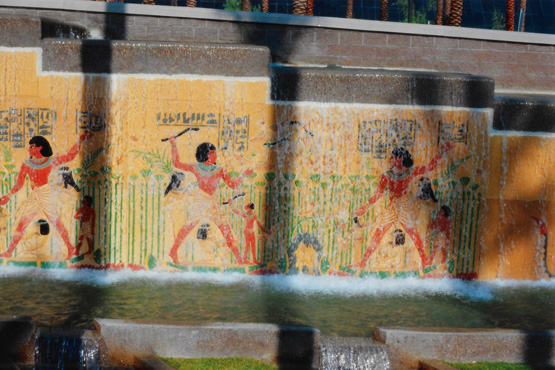 Simulated Egyptian Wall Painting at the Luxor All around the front of the hotel are reflecting pools and fountains. These Egyptian-style wall paintings are in back of one of the series of fountains. The driveway is going across the picture at the top. Fred took this picture, and I think it is interesting with the shadows and all. The water features were very extensive. |
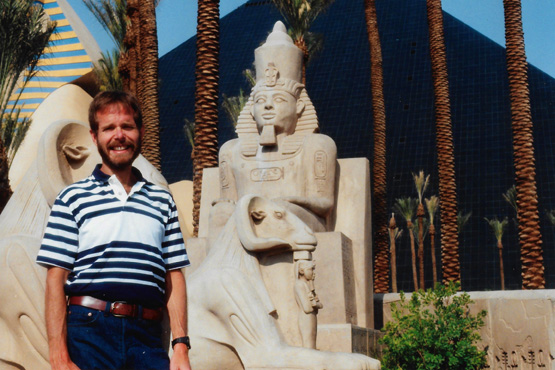 Me and Some of the Statuary Outside the Luxor I know I have a pained expression on my face, but I couldn't help it- I was looking directly into the morning sun. I continue to be impressed with how much time and trouble the casinos go to to create all this decoration (which is actually quite good). |
In the lobby of the Luxor (5), there are lots of attractions for kids, including an immense arcade. For the kids and the adults, there is a series of three "virtual reality" rides. Essentially, you are in a stationary vehicle (a flying transport, in our case) which is surrounded by a 360-degree movie screen. There is always some sort of plot (in this case, some tourist have to be evacuated quickly from deep inside an excavated pyramid where some mysterious treasure has been discovered, only to run into forces trying to wreck the transport), and the open vehicle rocks, sways and pitches in synchronization with the movie, so that you have the feeling you are really in the middle of the action. There are smells, and lights and smoke (when necessary) to enhance the effect. We had seen the rides last night, but they had already closed, and we wanted to get on the first ride of the day so we would have plenty of time to get to Phoenix.
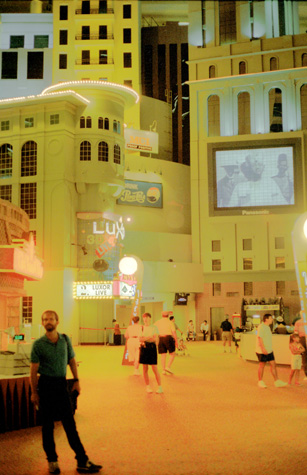 Amusements in the Luxor Lobby Atrium |
(Picture at left) The lobby is huge; the entrance to the second of the rides is across the way under the movie marquee. The ride was a lot of fun, although I will admit that by the end of it, I was feeling distinctly queasy. While the plot and move aren't realistic, the sensations caused by the movement of the car in time with the film are very real, what with all the pitching and rolling. In this ride, as in most others like it, the vehicle is supposedly airborne, which enhances the opportunities for motion. In addition, the entrance to the ride give the impression that you have indeed gone way down into some sort of excavation, when in fact you haven't left the level you start out on.
(Picture at right)
|
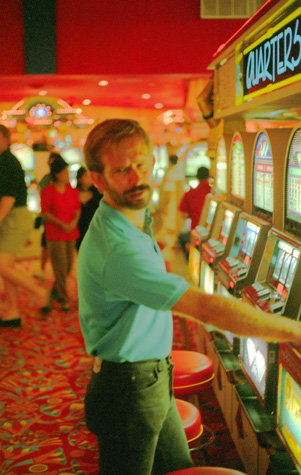 Playing the Slots |
When we left the Luxor, we walked north along The Strip to come back to the corner by the Excalibur (6). Here, we had better views of the MGM Grand across the intersection.
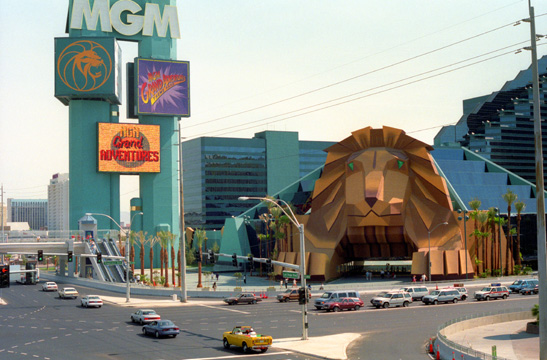 The MGM Grand (West End of South Walkway) At the Excalibur's corner, we first went up onto the elevated walkway south of the intersection to get this view. Most of the hotel itself is out of the picture to the right. |
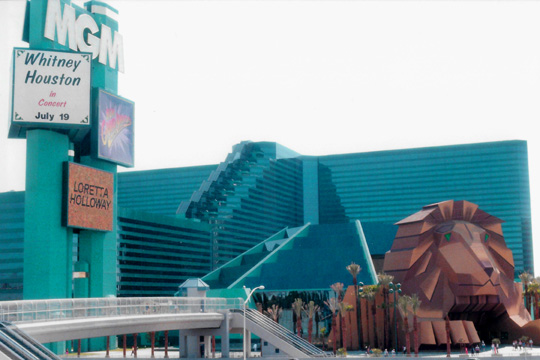 The MGM Grand (From the West Walkway) We decided to make a full circuit of the elevated walkways, so we next crossed the one leading from the Excalibur north, where we got this view of the MGM Grand. Then we crossed the northern walkway back to the La Quinta. |
After getting that last picture, we went back to the La Quinta and checked out. We had to head off for Phoenix to make sure of catching our five o'clock flight back to Dallas.
|
We headed out of Las Vegas on US 93. In Henderson, we passed a Baskin-Robbins that wasn't open yet, but when we went through Boulder City, Nevada, we found another one (quite by chance) and stopped to add it to my list. We then crossed over the top of Hoover Dam at Lake Mead to enter Arizona.
Both Fred and I had been to Hoover Dam before (Fred when he was very young) so we did not think it any particular loss not to stop for more than a few minutes at one of the overlooks.
Continuing on, we found another Baskin-Robbins in Kingman, Arizona, and then we drove straight on in to Phoenix on US 93 and US 89, connected back up with I-17 and went right to the airport. We returned the car, checked the luggage and made the Southwest Airlines flight in plenty of time. After a change of planes in El Paso, we arrived in Dallas about ten-thirty, and were home by eleven o'clock.
Our circular trip through northern Arizona, southern Utah and southern Nevada was another incredible experience. We saw and did a very great deal. I only wish that more Americans could experience the natural and made-made wonders of the American West.
You can use the links below to continue to another photo album page.
 |
July 3, 1994: Bryce Canyon NP/Cedar Breaks NM |
 |
Return to the Index for Our Western Trip |